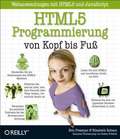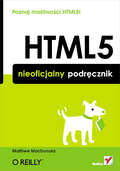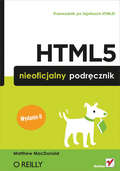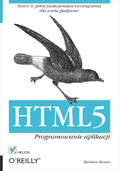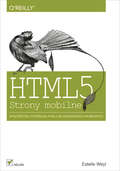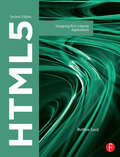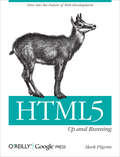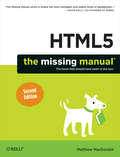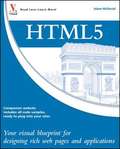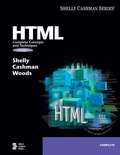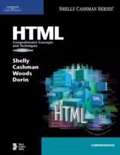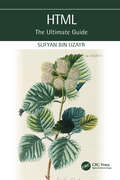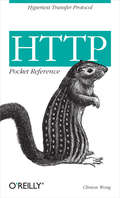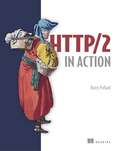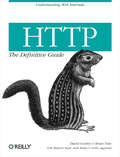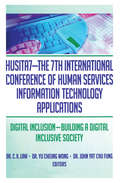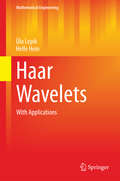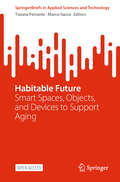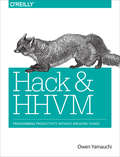- Table View
- List View
HTML5-Programmierung von Kopf bis Fuß
by Eric Freeman Elisabeth RobsonAls neueste Version der Markup-Sprache ist HTML5 vor allem praxisorientiert und auf die Entwicklung echter Webapplikationen abgestimmt - es erleichtert die Gestaltung von Webseiten mit lokaler Speicherung, macht 2-D-Zeichnungen, Geolocation und Offline-Unterstützung für Webanwendungen möglich, und unterstützt das Einbinden von Video- und Audio-Dateien ohne zusätzliches Plug-in. "HTML5-Programmierung von Kopf bis Fuß" vermittelt in bewährter Von Kopf bis Fuß-Tradition anhand zahlreicher praktischer Beispiele, grafischer Elemente und Übungen auf kluge und spielerische Art die Neuerungen, die HTML5 so spannend machen und sorgt gleichzeitig dafür, dass Ihnen das Lernen nicht nur Spaß macht, sondern Sie auch behalten, was Sie gelesen haben. Dieses Buch wendet sich hierbei an Entwickler von Webanwendungen, die bereits HTML- und CSS-Kenntnisse mitbringen und die ihre Konzentration voll auf die Neuerungen und Verbesserungen von HTML5 richten wollen.
HTML5. Nieoficjalny podr?cznik
by Matthew MacDonaldPoznaj mo?liwo?ci HTML5!HTML5 to co? wi?cej ni? j?zyk s?u??cy do tworzenia stron WWW — to zbiór kilkunastu niezale?nych standardów sieciowych pod jednym wspólnym szyldem. Z rozmachem wkracza do codziennego ?ycia projektantów stron internetowych. Jego nowe mo?liwo?ci naprawd? robi? wra?enie: obejmuj? ?cis?? integracj? ze ?rodowiskiem przegl?darki internetowej, us?ugi geolokalizacyjne, doskona?e wsparcie dla multimediów i aplikacji offline. Jeszcze niedawno takie mo?liwo?ci nie ?ni?y si? ?adnym webmasterom, a dzi? s? w zasi?gu ka?dego!Dzi?ki kolejnej ksi??ce z serii "Nieoficjalny podr?cznik" nie musisz odkrywa? tajników HTML5 na w?asn? r?k?. Znajdziesz tu wszystkie istotne informacje, dzi?ki którym b?yskawicznie zaczniesz korzysta? z dobrodziejstw HTML5. W trakcie lektury nauczysz si? dynamicznie rysowa? elementy, u?ywa? geolokalizacji oraz przechowywa? dane u?ytkowników w lokalnych magazynach danych. Ponadto poznasz nowe znaczniki oraz ich przeznaczenie. HTML5 to przysz?o?? sieci, dlatego ju? dzi? warto pozna? jego mo?liwo?ci!HTML5 to:wsparcie dla plików multimedialnychus?ugi geolokalizacyjnewygodne przechowywanie danychaplikacje offlinestandard nowoczesnej sieci Internet!Sprawd?, jak b?dzie wygl?da? sie? jutra, i zacznij korzysta? z tego ju? dzi?!
HTML5. Nieoficjalny podr?cznik. Wydanie II
by Matthew MacDonaldPrzewodnik po tajnikach HTML5!HTML5 na dobre zadomowi? si? w sieci. Z jego dobrodziejstw gar?ciami czerpi? projektanci witryn — i zaskakuj? u?ytkowników coraz bardziej pomys?owymi aplikacjami. HTML5 zapewnia zaawansowan? integracj? ze ?rodowiskiem przegl?darki internetowej, us?ugi geolokalizacyjne oraz doskona?e wsparcie dla materia?ów multimedialnych czy aplikacji offline. Jeszcze ca?kiem niedawno nikt nie marzy? o rzeczach, na jakie obecnie ten j?zyk programowania pozwala twórcom stron!Ksi??ka, któr? trzymasz w r?kach, nale?y do cenionej serii „Nieoficjalny podr?cznik”. Jej kolejne wydanie zosta?o poprawione, zaktualizowane i rozszerzone o mnóstwo nowych informacji. Dzi?ki tej publikacji nie musisz odkrywa? tajników HTML5 na w?asn? r?k?. Liczne przyk?ady oraz szczegó?owe omówienie najró?niejszych zagadnie? sprawi?, ?e w mig opanujesz niuanse tego j?zyka. W trakcie lektury dowiesz si?, jak wykorzysta? nowy element canvas i jak bez trudu zlokalizowa? u?ytkownika, oraz zobaczysz, jak przechowa? kluczowe dane w bazie przegl?darki. Si?gnij po t? ksi??k? i przekonaj si?, jakie mo?liwo?ci daje Ci HTML5!HTML5 to: wsparcie dla plików multimedialnych us?ugi geolokalizacyjne wygodne przechowywanie danych aplikacje offline standard nowoczesnej sieci InternetPoznaj mo?liwo?ci HTML5 i zacznij korzysta? z nich ju? dzi?!
HTML5. Programowanie aplikacji
by Zachary KessinW sieci trwa w?a?nie rewolucja! Do w?adzy dochodzi j?zyk HTML5!Jego potencja? jest nieograniczony - ?cis?a integracja z przeglšdarkš internetowš, wydajna obs?uga grafiki czy wsparcie dla geolokalizacji to tylko niektóre z jego atutów. Korzystajšc z jego mo?liwo?ci, mo?esz stworzy? ?wietnš gr? lub przydatnš aplikacj? internetowš. Poznaj pe?ne mo?liwo?ci j?zyka HTML5 i dowiedz si?, jak budowa? kompletne i autonomiczne aplikacje, dzia?ajšce na urzšdzeniach przeno?nych i konkurujšce z tradycyjnymi aplikacjami. Dzi?ki temu praktycznemu przewodnikowi odkryjesz skuteczne metody pracy z j?zykiem HTML5, takie jak lokalne magazynowanie danych i przetwarzanie wielowštkowe. Zaznajomisz si? równie? z zaawansowanymi narz?dziami JavaScriptu, które u?atwiajš korzystanie z ca?ej gamy elementów j?zyka HTML5. Je?li jeste? do?wiadczonym programistš JavaScriptu, umieszczone w ksiš?ce przyk?adowe kody poka?š Ci, jak j?zyk HTML5 zamienia sie? WWW w pierwszorz?dne ?rodowisko programistyczne.Zobacz, jak:testowa? aplikacje internetowekorzysta? z bazy IndexedDBpracowa? w trybie offlinewykorzysta? gniazda WWWDo?šcz do zaawansowanych u?ytkowników HTML5!
HTML5. Strony mobilne
by Estelle WeylWykorzystaj potencja? HTML5 na urz?dzeniach mobilnych!HTML5 to prawdziwa rewolucja w ?wiecie stron WWW i aplikacji internetowych. Jego potencja? oraz mo?liwo?ci zaskoczy?y niejedn? osob?. Wykorzystywany jest do tworzenia atrakcyjnych, intuicyjnych i dynamicznych stron WWW. To nie wszystko! Dzi?ki HTML5 i CSS3 mo?esz tak?e stworzy? aplikacj? dzia?aj?c? na urz?dzeniach z systemami Android lub iOS. Chcesz zobaczy?, jak to osi?gn???Je?li tak, to trafi?e? na ?wietn? ksi??k?, która wprowadzi Ci? w ?wiat nowoczesnych stron i aplikacji. W trakcie lektury zaczniesz poznawa? sk?adni? oraz mo?liwo?ci HTML, przygotujesz ?rodowisko pracy oraz zdob?dziesz potrzebne narz?dzia. Kolejne rozdzia?y to obowi?zkowa dawka informacji na temat tworzenia formularzy oraz korzystania z elementów svg, canvas, audio i video. HTML5 dostarcza wielu nowych narz?dzi, pozwalaj?cych m.in. sprawdzi? stan po??czenia z sieci?, przechowywa? dane na komputerze u?ytkownika lub uzyska? informacj? o jego lokalizacji. Dzi?ki tej ksi??ce opanujesz je w mig. W tym podr?czniku znajdziesz równie? obszerny opis kaskadowych arkuszy stylów w wersji 3. Pozwol? Ci one b?yskawicznie wprowadza? atrakcyjne dla oka efekty. Ksi??ka ta jest genialnym ?ród?em informacji dla wszystkich pasjonatów tworzenia stron i aplikacji internetowych.Dzi?ki tej ksi??ce:poznasz sk?adni? HTML5 i CSS3zaznajomisz si? z mo?liwo?ciami APIzbudujesz zaawansowan? stron? lub mobiln? aplikacj? internetow?Sprawd?, jak stworzy? aplikacj? internetow? dzia?aj?c? na platformie Android lub iOS!
HTML5: Designing Rich Internet Applications
by Matthew DavidImplement the powerful multimedia and interactive capabilities offered by HTML5, including style control tools, illustration tools, video, audio, and rich media solutions. Understand how HTML5 is changing the web development game with this project-based book that shows you-not just tells you-what HTML5 can do for your websites. Reinforce your practical understanding of the new standard with demo applications and tutorials, so that execution is one short step away. HTML5 is the future of the web. Literally every web designer and developer needs to know how to use this language to create the types of web sites consumers now expect. This new edition of the bestseller teaches you to enhance your web designs with rich media solutions and interactivity, using detailed descriptions and hands-on projects for every step along the way. The second edition contains completely updated information, including more on mobility and video standards, plus new projects. The companion website, visualizetheweb.com, is packed full of extra information, online code libraries, and a user forum, offering even more opportunity to learn new skills, practice your coding and interact with other users.
HTML5: Dive into the Future of Web Development
by Mark PilgrimIf you don't know about the new features available in HTML5, now's the time to find out. This book provides practical information about how and why the latest version of this markup language will significantly change the way you develop for the Web.HTML5 is still evolving, yet browsers such as Safari, Mozilla, Opera, and Chrome already support many of its features -- and mobile browsers are even farther ahead. HTML5: Up & Running carefully guides you though the important changes in this version with lots of hands-on examples, including markup, graphics, and screenshots. You'll learn how to use HTML5 markup to add video, offline capabilities, and more -- and you’ll be able to put that functionality to work right away.Learn new semantic elements, such as , , and Meet Canvas, a 2D drawing surface you can program with JavaScriptEmbed video in your web pages without third-party pluginsUse Geolocation to let web application visitors share their physical locationTake advantage of local storage capacity that goes way beyond cookiesBuild offline web applications that work after network access is disconnectedLearn about several new input types for web formsCreate your own custom vocabularies in HTML5 with microdata
HTML5: The Missing Manual
by Matthew MacDonaldHTML5 is more than a markup language—it’s a collection of several independent web standards. Fortunately, this expanded guide covers everything you need in one convenient place. With step-by-step tutorials and real-world examples, HTML5: The Missing Manual shows you how to build web apps that include video tools, dynamic graphics, geolocation, offline features, and responsive layouts for mobile devices.The important stuff you need to know:Structure web pages more effectively. Learn how HTML5 helps web design tools and search engines work smarter.Add audio and video without plugins. Build playback pages that work in every browser.Create stunning visuals with Canvas. Draw shapes, pictures, and text; play animations; and run interactive games.Jazz up your pages with CSS3. Add fancy fonts and eye-catching effects with transitions and animation.Design better web forms. Collect information from visitors more efficiently with HTML5 form elements.Build it once, run it everywhere. Use responsive design to make your site look good on desktops, tablets, and smartphones.Include rich desktop features. Build self-sufficient web apps that work offline and store the data users need.
HTML5: Your visual blueprint for designing rich web pages and applications
by Adam McdanielUse the latest version of HTML to create dynamic Web pages HTML5 is the latest iteration of the standard markup language for creating Web pages. It boasts extensive updates from its predecessor and allows you to incorporate rich media content into a site without any dependence on extra software such as Flash. Packed with hundreds of screen shots, this visual guide introduces you to the many new features and abilities of HTML5 and shows you the many exciting new possibilities that exist for designing dynamic Web pages. Offers visual learners a solid reference on HTML5, the latest version of the standard markup language for designing Web pages Demonstrates how to use HTML5 to create Web pages that feature the latest in rich media content Provides easy-to-understand examples that cover a variety of topics to get you up and running with HTML5 Features a companion Web site that contains all the code needed to learn HTML5 HTML5: Your visual blueprint for designing effective Web pages opens your eyes to the world of possibilities that exist with the new version of the popular markup language. Adam R. McDaniel is a Web developer, technical architect, and security analyst, who has contributed to the Linux Kernel.
HTML: Complete Concepts and Techniques
by Denise M. Woods Gary B. Shelly Thomas J. CashmanPart of the highly successful Shelly Cashman series, this introductory text leads the user through a clear, step-by-step, screen-by-screen approach to learning HTML. Readers learn how to create a Web page using HTML, format the page, add graphics, and more with this exciting new edition.
HTML: Comprehensive Concepts and Techniques
by Denise M. Woods Gary B. Shelly William J. DorinPart of the highly successful Shelly Cashman series, this text provides a comprehensive introduction to HTML and leads the user through a clear, step-by-step, screen-by-screen approach to learning. Readers learn how to create a Web page using HTML, format the page, add graphics, and more.
HTML: Comprehensive Concepts and Techniques
by Denise M. Woods Gary B. Shelly Thomas J. Cashman William J. DorinPart of the highly successful Shelly Cashman series, this introductory text leads the user through a clear, step-by-step, screen-by-screen approach to learning HTML. Readers learn how to create a Web page using HTML, format the page, add graphics, and more.
HTML: The Ultimate Guide (The Ultimate Guide)
by Sufyan bin UzayrHTML code is a programming language used in website building and website templates. It is used to format the look and format of a web page, to set design features such as basic layout, colors, and fonts. HTML: The Ultimate Guide provides a crash course in HTML, its history, key features, different versions available, various tags and elements, as well as the advantages and disadvantages. This book also covers the fundamental concepts of CSS and JavaScript and guides the reader through creating websites and games with these tools. As the reader progresses through the lessons, they will learn how to insert JavaScript commands directly into the HTML document, and how the script executes when viewed in browser. This is a valuable resource for anyone who wants to create a website or any 2D or 3D game in HTML. After finishing this book, readers will be able to quickly build their website or game with absolute ease. This book: Discusses code optimization in HTML code, Web Scripting and Security ideas in HTML. Introduces HTML for Game Development, benefits and types of games (2D and 3D). Includes a Cheat Sheet of HTML where you will get all key terms and useful information that is easy to access.
HTTP - Lo mínimo que todo desarrollador web debe saber
by Marcelo GalhegoTodo este recorrido tiene un comienzo y creo que, si usted está buscando ser un desarrollador web pero no sabe cómo ni por dónde comenzar, este libro puede ser su primer paso en este fantástico viaje. Espero que este libro le ayude a alcanzar sus objetivos y a transformar sus sueños en realidad.
HTTP Pocket Reference: Hypertext Transfer Protocol
by Clinton WongThe HyperText Transfer Protocol, or HTTP, is the backbone of the World Wide Web. HTTP is the language that each web browser (or other web client) uses to communicate with servers around the world. All web programmers, administrators, and application developers need to be familiar with HTTP in order to work effectively.The HTTP Pocket Reference not only provides a solid conceptual foundation of HTTP, it also serves as a quick reference to each of the headers and status codes that comprise an HTTP transaction. The book starts with a tutorial of HTTP, but then explains the client request and server responses in more detail, and gives a thorough technical explanation of more advanced features of HTTP (such as persistent connections and caching).Most people use the Web every day without knowing anything about HTTP, but for those who need to get "beyond the browser," this book is the place to start.
HTTP/2 in Action
by Barry PollardSummaryHTTP/2 in Action is a complete guide to HTTP/2, one of the core protocols of the web. Because HTTP/2 has been designed to be easy to transition to, including keeping it backwards compatible, adoption is rapid and expected to increase over the next few years. Concentrating on practical matters, this interesting book presents key HTTP/2 concepts such as frames, streams, and multiplexing and explores how they affect the performance and behavior of your websites.Purchase of the print book includes a free eBook in PDF, Kindle, and ePub formats from Manning Publications.About the TechnologyHTTP—Hypertext Transfer Protocol—is the standard for exchanging messages between websites and browsers. And after 20 years, it's gotten a much-needed upgrade. With support for streams, server push, header compression, and prioritization, HTTP/2 delivers vast improvements in speed, security, and efficiency.About the BookHTTP/2 in Action teaches you everything you need to know to use HTTP/2 effectively. You'll learn how to optimize web performance with new features like frames, multiplexing, and push. You'll also explore real-world examples on advanced topics like flow control and dependencies. With ready-to-implement tips and best practices, this practical guide is sure to get you—and your websites—up to speed!What's InsideHTTP/2 for web developersUpgrading and troubleshootingReal-world examples and case studiesQUIC and HTTP/3About the ReaderWritten for web developers and site administrators.About the AuthorsBarry Pollard is a professional developer with two decades of experience developing, supporting, and tuning software and infrastructure.Table of ContentsPART 1 MOVING TO HTTP/2Web technologies and HTTPThe road to HTTP/2 Upgrading to HTTP/2PART 2 USING HTTP/2HTTP/2 protocol basicsImplementing HTTP/2 pushOptimizing for HTTP/2PART 3 ADVANCED HTTP/2Advanced HTTP/2 conceptsHPACK header compressionPART 4 THE FUTURE OF HTTPTCP, QUIC, and HTTP/3Where HTTP goes from here
HTTP: The Definitive Guide
by David Gourley Brian Totty Marjorie Sayer Anshu Aggarwal Sailu ReddyBehind every web transaction lies the Hypertext Transfer Protocol (HTTP) --- the language of web browsers and servers, of portals and search engines, of e-commerce and web services. Understanding HTTP is essential for practically all web-based programming, design, analysis, and administration.While the basics of HTTP are elegantly simple, the protocol's advanced features are notoriously confusing, because they knit together complex technologies and terminology from many disciplines. This book clearly explains HTTP and these interrelated core technologies, in twenty-one logically organized chapters, backed up by hundreds of detailed illustrations and examples, and convenient reference appendices. HTTP: The Definitive Guide explains everything people need to use HTTP efficiently -- including the "black arts" and "tricks of the trade" -- in a concise and readable manner.In addition to explaining the basic HTTP features, syntax and guidelines, this book clarifies related, but often misunderstood topics, such as: TCP connection management, web proxy and cache architectures, web robots and robots.txt files, Basic and Digest authentication, secure HTTP transactions, entity body processing, internationalized content, and traffic redirection.Many technical professionals will benefit from this book. Internet architects and developers who need to design and develop software, IT professionals who need to understand Internet architectural components and interactions, multimedia designers who need to publish and host multimedia, performance engineers who need to optimize web performance, technical marketing professionals who need a clear picture of core web architectures and protocols, as well as untold numbers of students and hobbyists will all benefit from the knowledge packed in this volume.There are many books that explain how to use the Web, but this is the one that explains how the Web works. Written by experts with years of design and implementation experience, this book is the definitive technical bible that describes the "why" and the "how" of HTTP and web core technologies. HTTP: The Definitive Guide is an essential reference that no technically-inclined member of the Internet community should be without.
HTTP: The Definitive Guide
by David Gourley Brian TottyWeb technology has become the foundation for all sorts of critical networked applications and far-reaching methods of data exchange, and beneath it all is a fundamental protocol: HyperText Transfer Protocol, or HTTP. HTTP: The Definitive Guide documents everything that technical people need for using HTTP efficiently. A reader can understand how web applications work, how the core Internet protocols and architectural building blocks interact, and how to correctly implement Internet clients and servers.
HUSITA7-The 7th International Conference of Human Services Information Technology Applications: Digital Inclusion—Building A Digital Inclusive Society
by C. K. Law Yu Cheung Wong John Yat Chu FungIn today’s information society, to make a real and lasting impact on human welfare takes applications of information technology aimed at enhancing access to all. HUSITA7-The 7th International Conference of Human Services Information Technology Applications: Digital Inclusion-Building a Digital Inclusive Society presents diverse viewpoints from around the globe, examining the latest applications of digital technology for social work education and practice. These conference presentations from respected international authorities discuss the application of ICT (information and communication technology) in various facets of human service to achieve the goal of a digital inclusive society where all have access to education and informational resources. HUSITA7-The 7th International Conference of Human Services Information Technology Applications examines the development and use of information technology in professional training, including the strengths and limitations of e-learning in social work curriculums along with the rationale behind a learning object approach. Research includes findings from educators in Canada describing the development and implementation of e-learning in social work programs and the qualitative study of technological content in an MSW curriculum. Various types of Web-based learning approaches are explored with an eye toward providing more effective teaching strategies. Various technological advances and approaches toward individual empowerment are described to facilitate greater societal inclusiveness. The book is well referenced and includes several helpful tables and figures. Topics in HUSITA7-The 7th International Conference of Human Services Information Technology Applications include: the learning object approach of e-learning for social work education challenges implementing e-learning in social work education a research study of the relationship between technology content in social work education and technology use in social work practice international partnerships in Web-based teaching effective integration of emotion into the content of Web-based learning the use of indigenous knowledge in content the use of Web CT for effective address of issues such as quality of teaching and communication bringing about social inclusion through effective digital government how technological advances impact assistive technology research on the Internet self-efficacy in older person’s learning of ICT a communication tool for the speech impaired improving social work service effectiveness through knowledge management (KM) the “SenSui” disability information resource in Japan HUSITA7-The 7th International Conference of Human Services Information Technology Applications is enlightening reading for librarians, social educators, social work students, researchers interested in ICT, and human service professionals.
Haar Wavelets
by Ülo Lepik Helle HeinThis is the first book to present a systematic review of applications of the Haar wavelet method for solving Calculus and Structural Mechanics problems. Haar wavelet-based solutions for a wide range of problems, such as various differential and integral equations, fractional equations, optimal control theory, buckling, bending and vibrations of elastic beams are considered. Numerical examples demonstrating the efficiency and accuracy of the Haar method are provided for all solutions.
Habitable Future: Smart Spaces, Objects, and Devices to Support Aging (SpringerBriefs in Applied Sciences and Technology)
by Marco Sacco Tiziana FerranteThis open-access book presents a multidisciplinary approach to the design of living spaces from an age-friendly perspective, in line with the Ambient Assisted Living (AAL) paradigm, which promotes the integration of assistive devices and technologies to create safe, comfortable environments that meet the needs of older adults and their caregivers. It outlines new operational strategies, incorporating an analysis of technological development trends focused on the well-being and health of older adults, identifying their needs and expectations through participatory processes, and establishing design requirements to foster the acceptance of interfaces and emerging devices. In light of the exponential increase in smart applications within living environments, the book emphasizes the necessity to introduce cutting-edge solutions for data transmission and processing, as well as the development of semantically driven tools to support designers in selecting and integrating assistive technologies through virtual environment simulations. The book also illustrates the methodological processes adopted in defining guidelines for the design of spaces dedicated to older adults, with attention to architectural and functional aspects in various domains: perceptual and sensory factors for the design of waiting areas in Community Houses, technological and environmental requirements for the integration of devices in home adaptation projects for Home Care and locational and typological criteria for the development of new Social Day Care Centers. These contributions are based on the experiences shared during the conference organized by the WP1 "Human-Centred Design and Evaluation, Certifications, Sustainability within the Built Environment" of Spoke9, within the framework of the Age-It/NRRP program.
Hack and HHVM: Programming Productivity Without Breaking Things
by Owen YamauchiHow can you take advantage of the HipHop Virtual Machine (HHVM) and the Hack programming language, two new technologies that Facebook developed to run their web servers? With this practical guide, Owen Yamauchi—a member of Facebook’s core Hack and HHVM teams—shows you how to get started with these battle-tested open-source tools.You’ll explore static typechecking and several other features that separate Hack from its PHP origins, and learn how to set up, configure, deploy, and monitor HHVM. Ideal for developers with basic PHP knowledge or experience with other languages, this book also demonstrates how these tools can be used with existing PHP codebases and new projects alike.Learn how Hack provides static typechecking while retaining PHP’s flexible, rapid development capabilityWrite typesafe code with Hack’s generics featureExplore HHVM, a just-in-time compilation runtime engine with full PHP compatibilityDive into Hack collections, asynchronous functions, and the XHP extension for PHPUnderstand Hack’s design rationale, including why it omits some PHP featuresUse Hack for multitasking, and for generating HTML securelyLearn tools for working with Hack code, including PHP-to-Hack migration
Hack the Cybersecurity Interview: A complete interview preparation guide for jumpstarting your cybersecurity career
by Ken Underhill Christophe Foulon Tia Hopkins Mari GallowayGet your dream job and set off on the right path to achieving success in the cybersecurity field with expert tips on preparing for interviews, understanding cybersecurity roles, and moreKey FeaturesGet well-versed with the interview process for cybersecurity job rolesPrepare for SOC analyst, penetration tester, malware analyst, digital forensics analyst, CISO, and more rolesUnderstand different key areas in each role and prepare for themBook DescriptionThis book is a comprehensive guide that helps both entry-level and experienced cybersecurity professionals prepare for interviews in a wide variety of career areas.Complete with the authors' answers to different cybersecurity interview questions, this easy-to-follow and actionable book will help you get ready and be confident. You'll learn how to prepare and form a winning strategy for job interviews. In addition to this, you'll also understand the most common technical and behavioral interview questions, learning from real cybersecurity professionals and executives with years of industry experience.By the end of this book, you'll be able to apply the knowledge you've gained to confidently pass your next job interview and achieve success on your cybersecurity career path.What you will learnUnderstand the most common and important cybersecurity rolesFocus on interview preparation for key cybersecurity areasIdentify how to answer important behavioral questionsBecome well versed in the technical side of the interviewGrasp key cybersecurity role-based questions and their answersDevelop confidence and handle stress like a proWho this book is forThis cybersecurity book is for college students, aspiring cybersecurity professionals, computer and software engineers, and anyone looking to prepare for a job interview for any cybersecurity role. The book is also for experienced cybersecurity professionals who want to improve their technical and behavioral interview skills. Recruitment managers can also use this book to conduct interviews and tests.
Hack the Cybersecurity Interview: Navigate Cybersecurity Interviews with Confidence, from Entry-level to Expert roles
by Christophe Foulon Ken Underhill Tia HopkinsAce your cybersecurity interview by unlocking expert strategies, technical insights, and career-boosting tips for securing top roles in the industryKey FeaturesMaster technical and behavioral interview questions for in-demand cybersecurity positions Improve personal branding, communication, and negotiation for interview success Gain insights into role-specific salary expectations, career growth, and job market trendsBook DescriptionThe cybersecurity field is evolving fast, and so are its job interviews. Hack the Cybersecurity Interview, Second Edition is your go-to guide for landing your dream cybersecurity job—whether you're breaking in or aiming for a senior role. This expanded edition builds on reader feedback, refines career paths, and updates strategies for success. With a real-world approach, it preps you for key technical and behavioral questions, covering roles like Cybersecurity Engineer, SOC Analyst, and CISO. You'll learn best practices for answering with confidence and standing out in a competitive market. The book helps you showcase problem-solving skills, highlight transferable experience, and navigate personal branding, job offers, and interview stress. Using the HACK method, it provides a structured approach to adapt to different roles and employer expectations. Whether you're switching careers, advancing in cybersecurity, or preparing for your first role, this book equips you with the insights, strategies, and confidence to secure your ideal cybersecurity job.What you will learnIdentify common interview questions for different roles Answer questions from a problem-solving perspectiveBuild a structured response for role-specific scenario questionsTap into your situational awareness when answering questionsShowcase your ability to handle evolving cyber threatsGrasp how to highlight relevant experience and transferable skillsLearn basic negotiation skillsLearn strategies to stay calm and perform your best under pressure Who this book is forThis book is ideal for anyone who is pursuing or advancing in a cybersecurity career. Whether professionals are aiming for entry-level roles or executive ones, this book will help them prepare for interviews across various cybersecurity paths. With common interview questions, personal branding tips, and technical and behavioral skill strategies, this guide equips professionals to confidently navigate the interview process and secure their ideal cybersecurity job.
Hack to The Future: How World Governments Relentlessly Pursue and Domesticate Hackers
by Emily CroseUnderstand the history of hacking culture and the genesis of a powerful modern subculture In Hack to the Future: How World Governments Relentlessly Pursue and Domesticate Hackers, veteran information security professional Emily Crose delivers a deep dive into the history of the United States government's nuanced relationship with hacker culture and the role the latter has played in the former's domestic policy and geopolitics. In the book, you'll learn about significant events that have changed the way the hacking community has been perceived by the public, the state, and other hackers. The author explains how the US government managed to weaponize a subculture widely seen as misanthropic and awkward into a lever of geopolitical power. You'll also discover how: The release of the Morris worm and the Melissa virus changed the way hackers were seen and treated in the United States Different government agencies, including the National Security Agency and NASA treated – and were treated by – domestic hackers Hacking went from being an exclusive hobby for socially awkward nerds to a substantial lever of geopolitical power in just a few decades Perfect for anyone with an interest in hacking, tech, infosec, and geopolitics, Hack to the Future is a must-read for those who seek to better their understanding of the history of hacking culture and how we got to where we are today.
